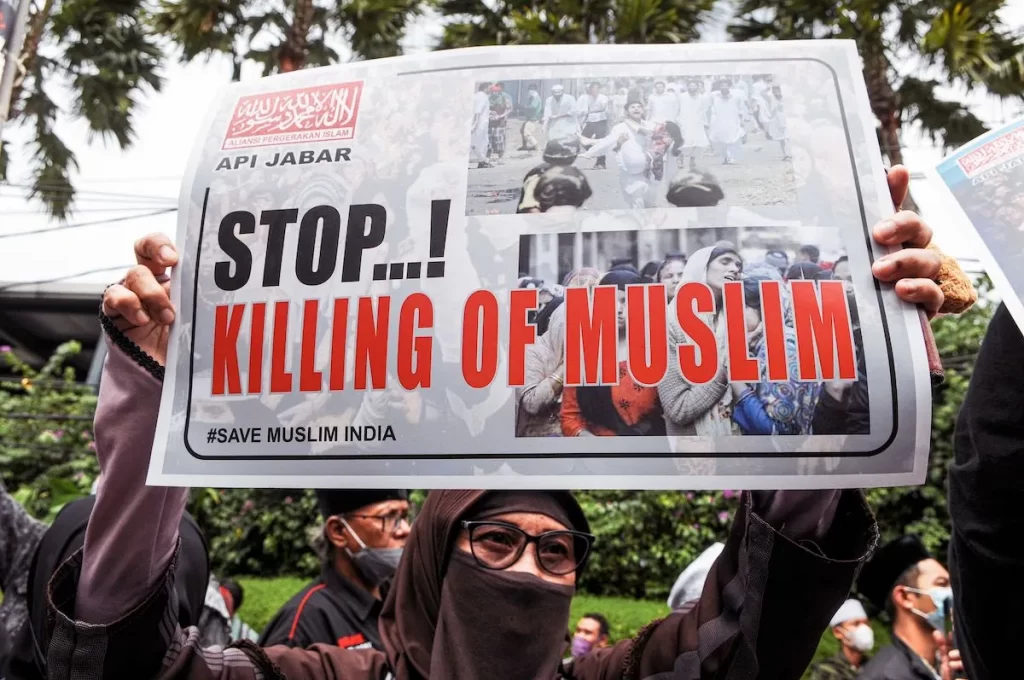
STRATEGIC ASSESSMENT- The virulent hate campaign by Hindutva forces promoted by the ruling right-wing Bharatiya Janata Party (BJP) of Prime Minister Narendra Modi, and subsequent rise in public and institutional Islamophobia, have combined to create panic among India’s 204 million Muslims, the country’s largest minority community. The mood was encapsulated by India’s opposition, along with France and the EU, to the UN General Assembly resolution sponsored by the Organisation of Islamic Cooperation (OIC) and eight other nations to mark the anniversary of the 2019 attacks on two mosques in New Zealand, by designating 15 March as the International Day to Combat Islamophobia. Fifty-one Muslims were killed in the mosque attacks.
In opposing the resolution, New Delhi sent a clear signal that it doesn’t care about the ongoing Muslim hatred prevailing in India. The adoption of the resolution followed a report last year by the UN special rapporteur on freedom of religion, in which it was said that anti-Muslim hatred had reached “epidemic proportions”. Examples of Islamophobia in both India and France were cited in the report.
A recent film, The Kashmir Files, is another attempt to incite hatred against Muslims through the manipulation of the facts. The film was produced and released to cover up and divert attention from the injustice done to the people of Kashmir and to distort the unsubstantiated allegations that the Hindu pandits — wise men — who lived like brothers with the Muslims in that state were tortured.
Prime Minister Modi and Interior Minister Amit Shah openly praised the film, even though is generates anti-Muslim feelings among Hindus, undermining the secular principles enshrined in the Constitution of India. In a country where mass murder and even ethnic cleansing of Muslims has been reported, highlighting the killing and exodus of upper cast Hindu Brahmins from Kashmir is part of a dangerous agenda to create an even tenser atmosphere, with anti-Muslim hate speeches and rhetoric making their way into cinemas. A video has circulated on social media showing a Hindu man calling on his community to father children from Muslim women. This was dated 18 March at a cinema where this film was being shown. It was an open call for the mass rape of Muslim women.
Rahul Dholakia’s film Parzania was based on the true story of Azhar Mody, the 13-year-old Parsi boy who went missing during the 2002 riots in Gujarat. When it was banned in that state despite being cleared by the board of censors, at least eight BJP-ruled states exempted The Kashmir Files from entertainment tax.
India’s government is controlled by the Sangh Parivar, a group of Hindu nationalist organisations inspired by the ideology of Rashtriya Swayamsevak Sangh (RSS), a militant fascist group. The government has been accused by human rights groups and the UN Human Rights Council of discrimination against Indian Muslims and of encouraging hate crimes by Hindutva elements against the minority community.
Around 14 per cent of India’s 1.35 billion people are Muslims. They feel more marginalised than ever under Modi’s government. The laws introduced by the federal and many state governments ruled by Modi’s party, and some of the verdicts announced by the courts, are direct attacks on the personal laws that allow marriage, divorce and inheritance according to the terms of the Islamic Shari’ah.
The current spate of Islamophobia in India is built on a long history of discrimination. India’s top court acquitted all 32 Hindu leaders, including former Prime Minister Lal Krishna Advani, who orchestrated the mob demolition of the 15th century Babri Mosque in 1992. Later, the Supreme Court ruled that the land where the mosque had stood belongs to Hindus. Barely four months after the controversial verdict, Chief Justice Ranjan Gogoi was nominated for the Upper House in parliament. This was the first time that the government had used its power to offer a post-retirement sinecure to a former Chief Justice of India.
The pogrom in the western Indian state of Gujarat in 2002 in which more than 2,000 Muslims were massacred by Hindu terrorists has been followed by scores of anti-Muslim communal riots. Moreover, a new citizenship law was introduced which marginalises the community, and a ban on hijab has been upheld by a state court, a decision that could set a precedent for the rest of the country. Such anti-Muslim moves cannot be ignored by the community.
Groups affiliated to the Sangh Parivar frequently unleash attacks against Muslims targeting halal food and other matters related to their faith. There are also many social media accounts that promote genocidal theories against Muslims and even encourage the sexual degradation of Muslim women using apps such as “Sulli Deals” and “Bulli Bai” that seek to enslave them.

In India, the hijab has historically been neither prohibited nor limited in the public sphere. Women donning the headscarf is a common sight across the country, which has religious freedom enshrined in its national Constitution, of which the secular state is the cornerstone.
However, on 15 March, the High Court in India’s southern state of Karnataka upheld the state government ban on wearing hijab in schools, saying that the headscarf is not an essential part of Islam. The ruling stunned not only the Muslims, but also liberal secularists who argued that it was a breach of the Constitution that provides the right to freedom of religion. Articles 25 to 28 of the Constitution recognise how important religion is in the life of the people of India. The Constitution envisages that every person has the right and freedom to choose and practise his or her religion.
“All persons are equally entitled to freedom of conscience and the right to freely profess, practice, and propagate religion subject to public order, morality and health,” explains Article 25. Furthermore, Article 26 says that all denominations can manage their own affairs in matters of religion.
The hijab is worn by Muslim women as a symbol of modesty. It is not simply an item of clothing, but is something mandated by Islam. However, the Sangh Parivar forces have unleashed a social media campaign against the hijab, and some of their leaders have even described the women who wear as “terrorist sympathisers” brainwashed by “radical Islamists”.
The leaders of the Sangh Parivar have apparently asked for a hijab ban in Narendra Modi’s home state of Gujarat, and have said that they will soon write to the country’s most populous state, Uttar Pradesh, where the BJP won another five-year mandate in the recent election.
The hijab controversy began in January when the authorities at a government-run junior college in Udupi, a coastal city in Karnataka, began refusing admission to girls who showed up in hijab, on the basis that they were “violating” the uniform code. The right-wing Hindutva gave the controversy a communal angle with students belonging to these organisations starting to wear saffron-coloured shawls. The colour is associated with their religion, but is not required by scripture to be worn.
At one campus, a boy climbed a flagpole and replaced the Indian flag with a saffron flag to cheers from Hindutva cadres. In another incident, a young woman in hijab was met at her college by a group of young men shouting Hindu slogans. She responded by raising her fist and chanting, “Allahu Akbar” (God is the Greatest).
It is interesting to note that a few days before the court verdict in Karnataka, a woman wearing hijab in the state was awarded 16 gold medals for her excellent academic record in Civil Engineering. Messages of congratulation poured in for Bushra Matin‘s achievement. Bollywood actor Swara Bhaskar, a fierce critic of Hindutva fascism, took to Twitter to highlight Bushra’s feat and targeted the opponents of the hijab by saying that they should move away from such closed thinking.
“Be it in school or college, hijab is not being discussed anywhere. I am thankful to the administration from my school to college for encouraging me on every occasion,” said Bushra after receiving the medals from Om Birla, a BJP leader and the Speaker of the Indian Parliament.
Far from enabling young women’s education, the anti-hijab court order has had the reverse effect, with thousands of Muslim girls staying away from classrooms across Karnataka. Their hopes now rest with the petition filed in the Supreme Court challenging the high court order. A judgement is expected within a few days.
In the meantime, the anti-Muslim hate campaign continues to tear India apart. It is to be hoped that the Supreme Court will take the opportunity to stop the slide towards officially-sanctioned religious hatred in what is still, in theory at least, a secular country.S







